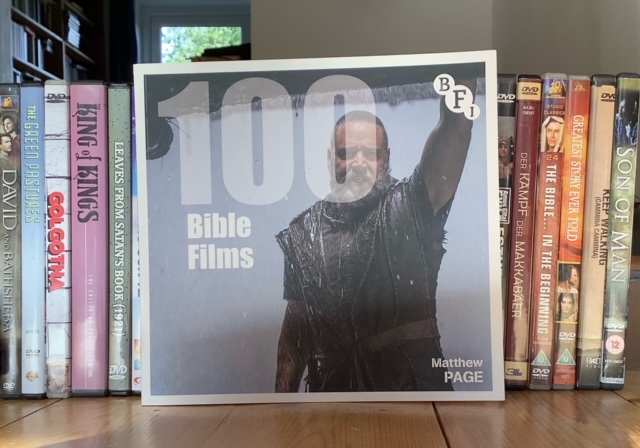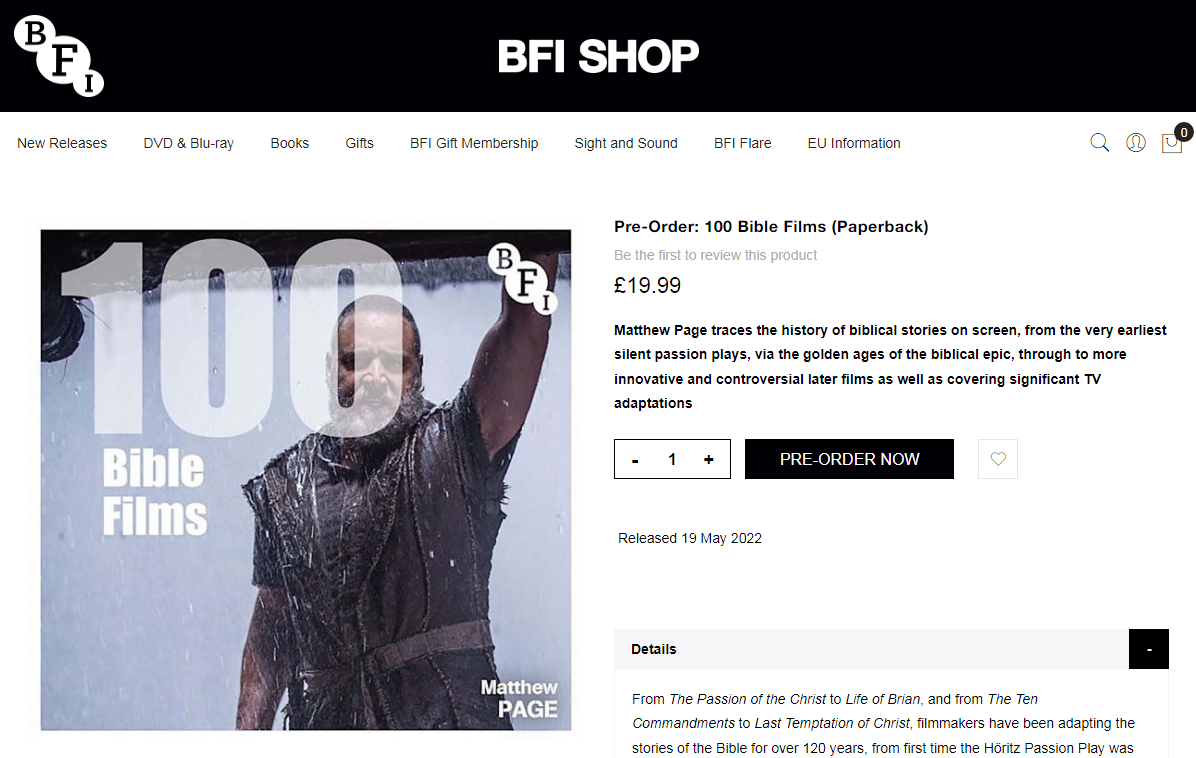One of the things that is so interesting about silent film is the possibilities for discovery: a lost classic turns up in an attic here, mention of a previously unknown movie is unearthed in a journal there. So it's genuinely exciting when an entire film turns up that no-one had ever even previously heard of. And this is precisely what's happened with Jesus the Christ (1923) which was released by Grapevine on DVD/Bluray and digital download a couple of weeks ago.
Grapevine's release is made all the more intriguing by the total lack of credits. There's no director's name so we can compare it with their other work; nor are we told the name of the actors who play Jesus or any of the other characters so we check out their past roles.
Herald Non-Theatrical Pictures
There is, however, a company name: "Herald Non-Theatrical Pictures". Terry Lindvall discusses this company in his book "Sanctuary Cinema: Origins of the Christian Film Industry". Herald was an off-shoot of periodical "Christian Herald" who first tried to get into the film business to promote a better quality of film but quickly ended up making them themselves. While much of their surviving footage was pro-prohibition pictures and "missionary films", in addition to this film apparently they also made "fourteen episodes of Old Testament history".(1) Periodicals from the time also record that the company was "non-sectarian",(2) and apparently this film specifically was "made at one of the renditions of the Passion Play in Europe".(3) Lindvall concludes that herald's efforts "constituted the most comprehensive film production effort by any religious organization of the silent era" yet notes that its "muted" demise shortly after "did not even make front-page copy".(4)
Compositions and lighting
The film itself belies the notion that Herald were just amateurs jumping on a band wagon. Some of their goals may have been a little naïve, but there is an undoubted artistry behind some of the compositions and lighting. This is certainly helped by Grapevine's excellent transfer (the digital download is 1080px full HD), but even an excellent copy cannot add what was not there to start with. The image above, for example, looks almost like a sepia-tinted Caravaggio imbued with a burgeoning sense of anticipation of the life that is to come. A long shot of Jesus carrying his cross across a ledge above (final image below) anticipates the famous closing shot of Bergman's The Seventh Seal (1957) while a shot into the tomb containing a freshly resurrected Jesus captures both its full-bodied nature and its inherent strangeness. It feels like the first time a film has really captured an event that left some overjoyed and others frightened and startled. This resurrected Jesus feels like he could credibly be both mistaken for something as mundane as a gardener (John 20:15) and something as extraordinary as a ghost (Luke 24:37). It's a shame the intertitles jump in here rather than leaving the camera to linger, but it's a wonderful moment nevertheless.

Recalling the earliest days of cinema
At the same time, this feels like a step back to an earlier era in cinema history. It feels like those early Pathé Bible films may well have impacted some of the filmmakers. There are several uses of the double exposures techniques which so typified Zecca's work, for example, which feel a little stagey here. One notable example – the Ascension – tips its hat to Zecca's La vie et Passion de N.S.Jésus-Christ (1907) in terms of composition, even if it omits its visual flourishes. Characters often bow in unison with their backs to the screen. Often the larger crowd scenes are filmed in long static shots while the crowd processes in or out.
Elsewhere in the world of the cinema, Robert Wiene was bringing German Expressionism to the masses with Das Kabinett des Doktor Caligari (1919) while films such as The Phantom Carriage (1921), Nosferatu(1922) and Haxan (1923) were emotionally affecting audiences in creative new ways. Meanwhile DeMille and Curtiz were reaching new heights in terms of spectacle and epic scale while the montage of Battleship Potemkin was only two years away. Compared to these more pioneering movies (and perhaps its unfair to compare a run of the mill film with some of the greatest example of what the medium is capable of) Jesus the Christ feels fairly antiquated. At the same time, I like slow cinema and and there something dignified and contemplative about its stately pacing.
A Filmed Passion Play
Having considered the film's visual contributions, what of the story? The suggestion that the film was made at a European passion play certainly chides with the film's structure, which would otherwise seem a little unusual. Of the film's 55 minute runtime, the first 5½ minutes (10%) cover Jesus' birth and childhood, the next 11 minutes cover Jesus' ministry (20%), with the remaining 70% covering the events of the 'final week' from his Triumphal Entry to his Ascension. In other words this is just a passion story with an extended prologue – a description that has also been used about Mark's Gospel.

The incidents that are featured in that brief 11 minute section are interesting though. We start with Jesus declaring his mandate in Nazareth and then casting a demon out of a boy. Next comes the Sermon on the Mount featuring a fair bit of the Beatitudes in the intertitles as instructions to be like children from Matthew 19. A woman is accused of adultery, then (prior to his triumphal entry) he casts the sellers out of the temple. Lastly he raises Lazarus. In other words this is a real jumble of highlights from the four Gospels harmonised into one account.
After the Last Supper and Gethsemane Jesus is tried before both Caiaphas (briefly) and Pontius Pilate (at greater length). Judas' remorse and suicide is also treated at length, most notably is the way that Judas also walks along the same rocky ledge that Jesus will take on his way to the cross moments later (mentioned above, pictured below). On the cross Jesus says five of the seven last phrases (Paradise, forgive them, I thirst, why forsaken, It is finished), then a procession takes him to his tomb. Pilate has the tomb sealed before the Resurrection and Ascension scenes mentioned above.
A Contemporary-style Jesus
The other-worldly nature of these final two scenes is given extra heft because of the very physical portrayal of Jesus that has preceded it. While the film generally feels most at home with mid-long shots, it does occasionally shoot Jesus in close-up. This is something even DeMille's The King of Kings (1927) is reticent about (the film's famous first shot of Jesus is a close up, but it's in soft focus, and a rare example). Here however, the occasional use of close-ups in combination with the high-contrast lighting really emphasises the wrinkles on Jesus' face. While he's nowhere near as old as H.B. Warner's Jesus he certainly seems older than Jeffrey Hunter's or Enrique Irazoqui's. There's something refreshingly real about the actor. Not only is he believably human, and a credible manual worker, he also seems grounded; he feels like someone who has experience of real life.

This is doubtless part of the reason (and only part) of why this unnamed actor playing Jesus somehow feels very contemporary. It's not just about the close-ups, it's the mid and wide shots as well. There's a lack of pretension or affect. Much of the footage simply doesn't feel like it's a hundred years old despite the apparent lack of technical sophistication. It's a salient reminder that artistic prowess can exist, even in the absence of innovation of form.
Jesus the Christ transcends its limited innovation regarding form to provide a fresh and groundbreaking portrait of Jesus the man.
Sadly, Herald Non-Theatrical Pictures never really took off and the film found itself stuck in a vault; it's backstory, and the lives of those who contributed to it, were eventually lost. I'm grateful, then, that Grapevine have rescued and restored it. It is by no means an exemplary film. The pacing of the film is a little off and perhaps part of the reason Herald lost out is their failure to remain contemporary in a fast-changing visual world. Nevertheless there are some beautiful moments and the presence of a contemporary-feeling, believable, Jesus in the midst of all this staid presentation somehow feels almost as paradoxical as the character himself.
You can download a copy of this film from the Grapevine Video website. Not only am I not affiliated with them I paid for my copy myself.
================
Labels: Silent Bible Films, Silent Jesus Films




















